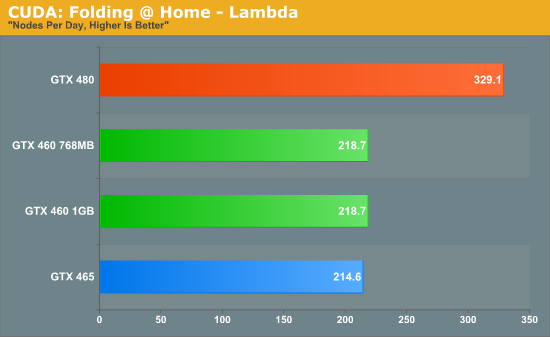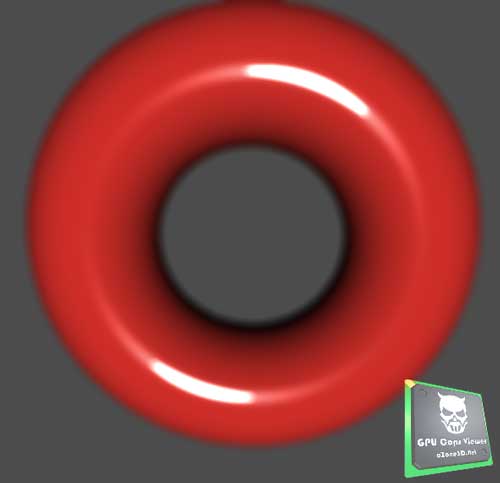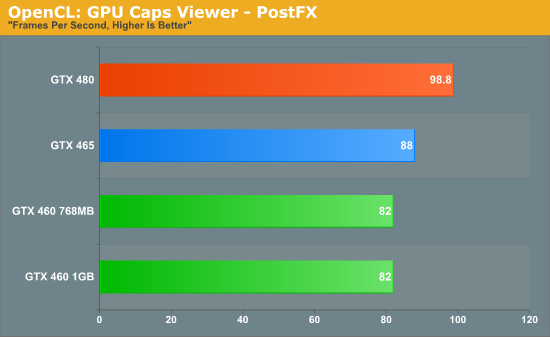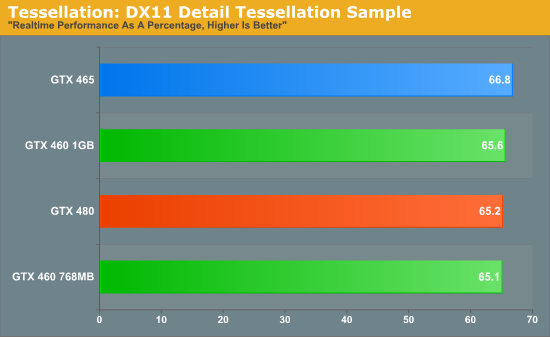NVIDIA’s GeForce GTX 460: The $200 King
by Ryan Smith on July 11, 2010 11:54 PM EST- Posted in
- GPUs
- GeForce GTX 400
- GeForce GTX 460
- NVIDIA
Compute & Tessellation Performance
With our earlier discussion on the GF104’s revised architecture in mind, along with our gaming benchmarks we have also run a selection of compute and tessellation benchmarks specifically to look at the architecture. Due to the fact that NVIDIA added an additional block of CUDA cores to an SM without adding another warp scheduler, the resulting superscalar design requires that the card extract ILP from the warps in order to simultaneously utilize all 3 blocks of CUDA cores.
As a result the range of best case to worst case scenarios is wider on GF104 than it is GF100: while GF100 could virtually always keep 2 warps going and reach peak utilization, GF104 can only reach peak utilization when at least 1 of the warps has an ILP-safe instruction waiting to go, otherwise the 3rd block of CUDA cores is effectively stalled and a GTX 460 performs more like a 224 CUDA core part. Conversely with a total of 4 dispatch units GF104 is capable of exceeding GF100’s efficiency by utilizing 4 of 7 execution blocks in an SM instead of 2 of 6.
Or in other words, GF104 has the possibility of being more or less efficient than GF100.
For our testing we’re utilizing a GTX 480, a GTX 465, and both versions of the GTX 460, the latter in particular to see if the lack of L2 cache or memory bandwidth will have a significant impact on compute performance. Something to keep in mind is that with its higher clockspeed, the GTX 460 has more compute performance on paper than the GTX 465 – 907GFLOPs for the GTX 460, versus 855GFLOPs for the GTX 465. As such the GTX 460 has the potential to win, but only when it can extract enough ILP to keep the 3rd block of CUDA cores working. Otherwise the worst case scenario – every math instruction is dependent – is 605GFLOPs for the GTX 460. Meanwhile the GTX 480 is capable of 1344GFLOPs, which means the GTX 465 and GTX 460 are 63% and 45%-67% as fast as it on paper respectively.

We’ll start with Stanford’s Folding@Home client. Here we’re using the same benchmark version of the client as from our GTX 480 article, running the Lambda work-unit. In this case we almost have a tie between the GTX 460 and the GTX 465, with the two differing by only a few nodes per day. The GTX 465 reaches 65% of the performance of the GTX 480 here, which is actually beyond the theoretical performance difference. In this case it’s likely that the GTX 480 may be held back elsewhere, allowing slower cards to shorten the gap by some degree.
With that in mind the GTX 460 cards achieve 66% of the performance of the GTX 480 here, giving them a slight edge over the GTX 465. Because we’ve seen the GTX 465 pull off better than perfect scaling here it’s very unlikely that the GTX 460 is actually achieving a perfect ILP scenario here, but clearly it must be close. Folding@Home is clearly not L2 cache or memory bandwidth dependent either, as the 768MB version of the GTX 460 does no worse than its 1GB counterpart.

Next up on our list of compute benchmarks is Badaboom, the CUDA-based video encoder. Here we’re measuring the average framerate for the encode of a 2 minute 1080i video cap. Right off the bat we’re seeing dramatically different results than we saw with Folding@Home, with the GTX 460 cards falling well behind the GTX 465. It’s immediately clear here that Badaboom is presenting a sub-optimal scenario for the GTX 460 where the GPU cannot effectively extract much ILP from the program’s warps. At 56% the speed of a GTX 480, this is worse off than what we saw with Folding@Home but is also right in the middle of our best/worst case scenarios – if anything Badaboom is probably very close to average.
Meanwhile this is another program with the lack of memory bandwidth and L2 cache is not affecting the 768MB card in the slightest, as it returns the same 35fps rate as the 1GB card.


Our third and final compute benchmark is the PostFX OpenCL benchmark from GPU Caps Viewer. The PostFX benchmark clearly isn’t solely compute limited on the GTX 400 series, giving us a fairly narrow range of results that are otherwise consistent with the Badaboom. At 82fps, this puts the GTX 460 below the GTX 465 by around 7%, once again showcasing that the superscalar GTX 460 has more trouble achieving its peak efficiency than the more straightforward GTX 465.


Our final benchmark is a quick look at tessellation. As GF104 packed more CUDA cores in to a SM, the GPU has more than half the compute capabilities of GF100 but only a straight 50% the geometry capabilities. Specifically, the GTX 460 has 45% of the geometry capabilities of the GTX 480 after taking in to account the number of active SMs and the clockspeed difference.
With the DirectX 11 Detail Tessellation sample program, we’re primarily looking at whether we can throw a high enough tessellation load at the GPU to overwhelm its tessellation abilities and bring it to its knees. In this case we cannot, as the GTX 460 scales from tessellation factor 7 to tessellation factor 11 by basically the same rate as the GTX 480 and GTX 465. This means that the GTX 460 still has plenty of tessellation power for even this demanding sample, but by the same measure it showcases than the GTX 480 is overbuilt if future games target GTX 460 for tessellation.
All things considered our compute and tessellation results are where we expected them to be. That is to say that the GTX 460’s wider range of best and worst case scenarios will show up in real-world programs, making its performance relative to a GTX 465 strongly application dependent. While the GF104 GPU’s architectural changes seem to be well tuned for gaming needs and leading to the GTX 460 meeting or beating the GTX 465, the same can’t be said for compute. At this point it would be a reasonable assumption that the GTX 465 is going to outperform the GTX 460 in most compute workloads, so the relevance of this for buyers is going to be how often they’re doing compute workloads and whether they can deal with the GTX 465’s lower power efficiency.










93 Comments
View All Comments
GeorgeH - Monday, July 12, 2010 - link
I actually think it should be called a 460. People with a reasonable amount of tech knowledge are going to know the difference, and people without it are already trained to think that a bigger RAM number is always better (see the tons of "bargain" cards with 1GB+ of slow DDR.)Basically, the performance differential here is already clear from the full product name, and we have one fewer model number muddying a GPU market already overflowing with a ridiculous amount of model names that have identical, nearly identical, or completely misleading performance capabilities relative to other model names.
Daeros - Monday, July 12, 2010 - link
I would agree with you except for the common practice of mfg's doubling up on VRAM. When that happens, there will be 768MB, 1GB, 1.5GB, and 2GB versions, and people will have no idea the 1.5GB will probably be slower than the 1GB version.tigersty1e - Monday, July 12, 2010 - link
This line made me read it twice."This in turn means the blades of the fan sit at the same height as the lip, blocking direct airflow out the back. With this design the card is still exhausting at least some air out of the rear of the card, but it shouldn’t be as much as a fully-open card such as our custom Asus GTX 460."
rear and back are the same thing. I think you meant to say the the cover blocks direct airflow out the front.
Ryan Smith - Monday, July 12, 2010 - link
I define the front of the card to be the side with the display ports, so the cover blocks airflow out of the opposite end, the back.fausto412 - Monday, July 12, 2010 - link
While a very nice card...too little too late...i got a 5870 3 weeks ago. if you have a high end quad core and want to play BFBC2 in the highest settings only a gtx480 or 5870 will do. i chose the cheaper, cooler and more efficient card.kumquatsrus - Monday, July 12, 2010 - link
or gtx 460 in sli for less?Jamahl - Monday, July 12, 2010 - link
Yeah look around, not just at Anand's flawed benches.TPU shows sli 460's losing to the 5970 by 20% at 1680 and 1920, and a massive 30% at 2560.
They aren't even close, but keep dreaming anyway.
DominionSeraph - Tuesday, July 13, 2010 - link
The reply was to a 5870, not 5970. Just a matter of $300 difference between the two.DrMrLordX - Monday, July 12, 2010 - link
On your power consumption + noise charts (at the very least), the Zotac card's results are shown with white text superimposed over a yellow bar on the graph. This makes the white text almost completely unreadable. One can guess at the numbers based on context, but still . . .bobjones32 - Monday, July 12, 2010 - link
The benchmarks look good at first look, but then I realized I purchased my current 4870 for $150 nearly a year and a half ago.Looking more closely at these benchmarks, the GTX 460 beats the 4870 in most tests, but not by that much, and at lower resolutions the 4870 actually wins.
Shouldn't it be clear-cut that a $200 brand new card from today destroys a $150 card from nearly a year and a half ago?